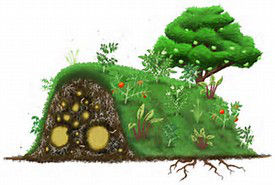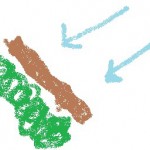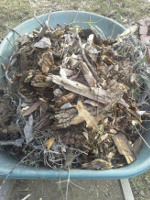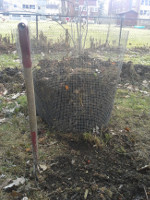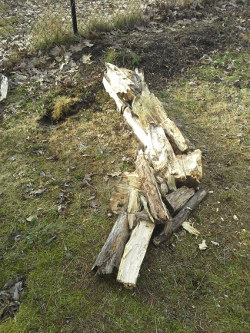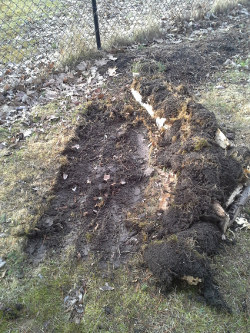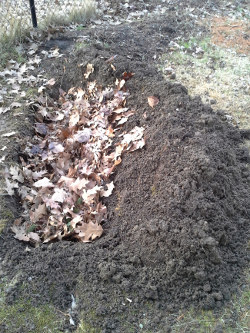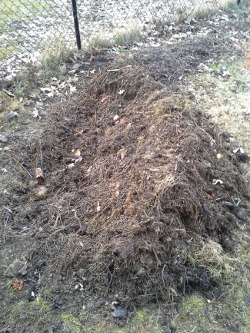What is Hugelkultur?
Hugelkultur is a method of raised bed gardening perfected by Austrian permaculture guru Sepp Holzer.
Another Permaculture expert, Paul Wheaton, has a good summary of Holzer’s work on his website richsoil.com.
You can also check out Sepp Holzer’s English website here as well as search the web for his books and videos.
Hugelkultur is a German word meaning mound or hill culture. “Culture’ in this context refers to growing things, so Hugelkultur basically means to grow plants on a mound or small hill.
The Concept
The beauty and secret behind Hugelkultur is that it is designed to mimic the natural soil fertilization process found in the forest by incorporating dead, rotting wood into the soil.
As discussed in our article on improving soil fertility, permaculture can be summarized as the practice of observing how plants grow in nature, particularly in forests, and then attempting to replicate the process at home.
As discussed eloquently by Toby Hemingway in his book Gaia’s Garden, the fertility of forest soil increases over time, if left undisturbed.
Forests grow larger yet the soil fertility is not depleted. In fact, the forest soil gets better over time and able to support more and larger plants.
This is an amazing concept given that we spend so much time adding nitrogen-based fertilizer, rotating crops, roto tilling, irrigating, etc., at home, continuously fighting to recharge our soil, and all the while the forest soil requires no outside inputs.
The fertility increase occurs because everything that drops onto the forest floor is left to decay. Dead wood, leaves, and the like absorb water and decay, slowly providing nutrients for the soil.
A Hugelkultur garden bed is basically a pile of wood with soil and compostable materials piled on top of it forming a mound that can accommodate plants.
As the wood decays over years, the soil is fertilized. The rotting wood also soaks up water for the plants, and some hugelkultur users find that they do not have to water their beds at all.
How to construct a Hugelkultur bed for the home garden
If you watch some Sepp Holzer videos on Youtube, the first impression is “Wow! Everything he is doing is awesome,” but later one realizes that none of these things are possible or acceptable for the average homeowner.
Holzer has a huge piece of land, and almost everything he does involves a bulldozer. His perfected Hugelkultur mound is 6 or 8 feet high and very wide and long.
The average urban or suburban gardener cannot do earthworks, but we can use scaled-down hugelkultur beds with much success in the home garden.
Basic Home Hugelkultur bed
A basic home Hugelkultur bed is constructed by first obtaining dead tree wood. Lay the wood out on the lawn or ground where the hugelkultur raised bed is going to live.
We have found that it is nice to pile the branches or wood pieces at least 6 inches to a foot high. Then, cover the wood with soil.
Cover the soil with compost or other organic mulch, and finally, cover the mulch with straw or hay. Once completed, toss in seeds or plants and water thoroughly.
You should see the same effects as that of a raised bed with the added bonus of increased fertility and moisture content.
If you do not have hay or straw, it is not necessary, but the straw helps to protect seeds while they are germinating. Once constructed, the Hugelkultur bed should be about 2 or three feet high.
We have found that about 2.5 feet tall by 6-8 feet long and about 1-2 feet wide is ideal for the backyard garden from an aesthetics point of view, but build it as large as desired.
Swale / Hugelkultur Bed “on Contour”
A more sophisticated version of the home hugelkultur bed can be built with the added aim of preventing soil erosion caused by rainwater moving across the lawn and property.
The first step in this process is to build a swale aka trench aka ditch about a foot wide, a foot deep, and as long as desired. To capture rainwater to be used by the Hugelkultur bed, build the swale on contour.
On contour means building the ditch perpendicular to the direction of rainwater flow on your property.
For example, if water is running North to South, a ditch on contour would run East/West in order for the rainwater to flow into the swale and be captured (not channeled away).
In the bad drawing below, the brown swale is built on contour in order to capture the rainwater flow shown by the blue arrows.
The Green structure is the Hugelkultur mound built on the downhill side of the swale.
Start by laying out the dead tree wood in a line on the downhill side of the swale (step-by-step photos are at bottom of this article).
As you dig the swale, throw the soil from the ditch onto the wood.
Toss any sod upside down onto the pile as well. Once completed, cover the Hugelkultur bed with compost and straw if available.
Also, fill the ditch with compost or other organic material until it is level with the rest of the lawn.
This way, the swale ditch will be hidden, but will still slow down and capture rainwater which will be soaked up by the logs and the plants in the bed. It is not necessary to fill the ditch, but it looks better and we don’t want any sprained ankles.
If you want, you can build these swale / Hugelkultur mounds strategically throughout the property in order to capture as much rainwater as possible.
In the event that a property has too much water flow coming in, the swale can be constructed slightly off contour, in order to redirect excess flow to another part of the property that could use the water, or even off property, being careful not to redirect water to neighbors in a way that would be harmful to their property.
Additional Hugelkultur ideas
Over time, as the wood in a Hugelkultur bed breaks down, this form of raised bed will become more and more productive.
Eventually, after a number of years, it may be necessary to rebuild the beds, if desired, after the wood is completely decomposed.
Also, periodically, we like to re-trench our swales by removing the contents, using them elsewhere in the garden, and re filling with mulch to make sure the swale is still working to its potential.
You’ll find that the swale begins to capture soil from your uphill neighbors’ property, and this soil can be dug out and used in the garden. A swale / Hugelkultur mound on contour is also a top soil generator in this way.
For the below swale, because it is at the back of the property, we chose not to fill it in with compost. We found that this swale acts as a soil generator, capturing soil that has run off of other properties uphill, and into our trench. High quality soil can be “harvested” from this swale several times per year.
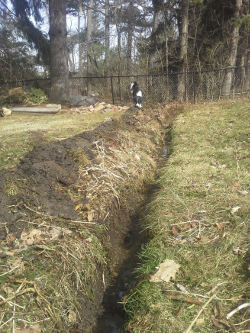
Give home hugelkultur beds a try and we believe you will love them.
They are a wonderful addition to the formal raised bed look and can even be used to replace traditional raised bed structures altogether.
We like to use formal raised beds made from repurposed pallet wood nearer to the house, and reserve the Swale/ Hugelkultur beds for areas further away from the home as well as in areas that require rainwater management.
An additional benefit of Hugelkultur is that the hill allows for what permaculture enthusiasts and others call microclimates, meaning that each part of the hill can vary in temperature, wind, sunlight, water availability, etc., and you may discover that some plants do well on one side of the hill as opposed to the other, or some like the top better and others the bottom.
With the smaller, Home Hugelkultur bed, the micro climates are not as diverse as they would be on, say, an 8 foot high bed that is 10 feet wide, but nevertheless, you may see some micro climates with the smaller hill.
Pro Tip: When building the mound, use what organic materials you have available such as leaves, grass clippings, compost, etc. and don’t worry about trying to build a perfect layered bed.
See our article on how to make your own compost.
For the wood, any tree wood will work. We use punk wood that is no longer suitable for burning (we don’t want to use valuable firewood, but you could).
We like to take a whole bunch of different seeds and mix them together the first year or two and toss them onto the hill, all over, and then observe what plants seems to thrive where.

Pro tip: Build mini hugelkultur berms with or without swales on the downhill side of fruit trees. The trees will benefit from the excess water and will send their roots into the mound.
Bonus tip: Lay down smaller wood pieces or branches inside of a traditional raised bed to benefit from some of the benefits of Hugelkultur.
Here’s How We Built One of Our Hugelkultur / Swale Beds on Contour:
Thanks for reading, and please share this article if you found it helpful.

